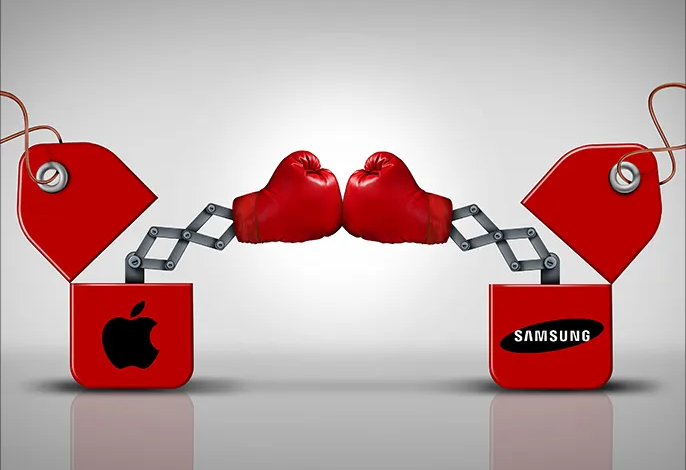A Fierce Technological Rivalry: Samsung vs. Apple in the Battle for Dominance

In an intense technological competition between industry giants, Samsung and Apple dominate the smart device landscape, with their rivalry shaping a long-term race for supremacy.
Although Samsung boasts a history nearly 40 years older, Apple revolutionized the game with the launch of the first iPhone in 2007, establishing itself as a primary competitor. Apple’s success is fueled by a loyal fan base and a network of innovations that have solidified its position as a symbol of excellence in product design and ecosystem integration.
On the other hand, Samsung faces significant challenges, particularly in maintaining its position in the smartphone market while expanding its presence in home appliances and artificial intelligence.
Samsung’s Path to Surpassing Apple
For years, the competition between Samsung and Apple has been the driving force behind advancements in consumer technology. The rivalry resembles an ongoing duel between two tech titans vying for innovation supremacy.
While Apple leads in profitability and brand loyalty, Samsung frequently surprises the world with bold innovations, such as foldable phones, cutting-edge displays, and diverse product offerings.
As 2025 approaches, it is evident that technological advancements alone are no longer sufficient to surpass Apple. The company has mastered the art of making its products an integral part of consumers’ lives, to the point where each new release compels users to purchase without hesitation.
For Samsung to reignite consumer passion and regain loyalty, it must adopt innovative strategies and rethink its approach.
Here are seven strategies Samsung can implement to reclaim its dominance:
1- Creating an Integrated Ecosystem to Challenge Apple’s Stronghold
Apple’s greatest strength lies in its seamless ecosystem, where iPhones, Apple Watch, Mac, and AirPods work together effortlessly. This connectivity provides users with an interconnected experience that locks them into Apple’s ecosystem.
Samsung, with its Galaxy smartphones, tablets, and wearables, has enormous potential but still struggles with fragmentation compared to Apple’s ecosystem.
What does Samsung need to do?
To compete with Apple’s ecosystem, Samsung must:
- Enhance Integration: Samsung already offers tools like Quick Share and Samsung Flow, but they need to be more reliable and widespread—similar to AirDrop and Handoff in Apple’s ecosystem. Imagine starting a document on a Galaxy Book and seamlessly continuing it on a Galaxy Z Fold5, just as Apple users do between Mac and iPad.
- Strengthen SmartThings: Apple’s HomeKit suffers from device compatibility limitations. Samsung can capitalize on this by expanding partnerships with third-party smart home manufacturers to make SmartThings the go-to platform for a smarter, more connected home.
- Introduce a Subscription Service: Apple’s Apple One has proven that bundled services attract consumers. Samsung should introduce comprehensive subscription packages that include cloud storage, exclusive apps, and device warranties—all for a fixed monthly fee.
2- Redefining Software Experience: How Can Samsung Rival Apple’s Smoothness?
Apple is renowned for its refined and well-optimized software. While Samsung often surpasses Apple in hardware, its One UI interface—built on Android—can feel cluttered or complex for some users.
How can Samsung improve?
- Refining One UI: Simplifying the interface without compromising customization. Features like Samsung DeX (desktop mode) are underutilized and could be made more user-friendly to become a unique selling point.
- Exclusive Features: Investing in unique tools for Galaxy users, such as advanced video editing apps or enhanced S Pen functionalities, could attract creative professionals who currently prefer Apple’s ecosystem.
- AI Innovations: Samsung must integrate powerful AI-driven features, such as predictive text, voice automation, and personalized recommendations based on machine learning.
Merely catching up with Siri or Google Assistant is not enough—Samsung must aim for leadership in AI-driven user experiences.
3- Innovating Beyond Smartphones: Can Samsung Outperform Apple in Emerging Technologies?
While smartphones remain the core focus of both companies, Samsung must strengthen its dominance in emerging tech sectors where Apple is just beginning to make an impact.
Samsung’s Key Opportunities:
- Leadership in Foldable Devices: Samsung is a pioneer in foldable phones with its Galaxy Z Fold and Z Flip series. By improving hinge durability, lowering costs, and enhancing multitasking capabilities, Samsung can make foldables mainstream before Apple enters the foldable market.
- Wearable Health Tech: While Galaxy Watch is impressive, Apple Watch remains the industry standard for health tracking. Samsung must invest in advanced health features, such as blood sugar monitoring and seamless app integration, to narrow the gap.
- Augmented and Virtual Reality (AR/VR): Apple’s Vision Pro has set new standards for AR/VR experiences. Samsung must respond with a competitive, affordable alternative by leveraging its partnership with Google for software and its expertise in display technology.
4- Sustainability as a Competitive Edge: Can Samsung Catch Up to Apple’s Green Initiatives?
Sustainability is no longer just a marketing trend—it has become a crucial factor for many consumers when making purchasing decisions.
While Apple has committed to achieving a carbon-neutral supply chain by 2030, Samsung has been slow to set similar goals.
This could harm Samsung’s brand perception, especially as global movements push for environmental responsibility.
What should Samsung do?
- Increase Use of Recycled Materials: Samsung has begun integrating eco-friendly components, but it needs to accelerate adoption and promote its green initiatives more effectively.
Samsung has the potential to regain its competitive edge by adopting these strategic innovations. The 2025 tech battle between Samsung and Apple will not just be about devices—it will be a test of who can deliver a seamless ecosystem, superior software, cutting-edge innovation, and sustainability leadership.
Who will emerge victorious? The battle for tech supremacy continues.








